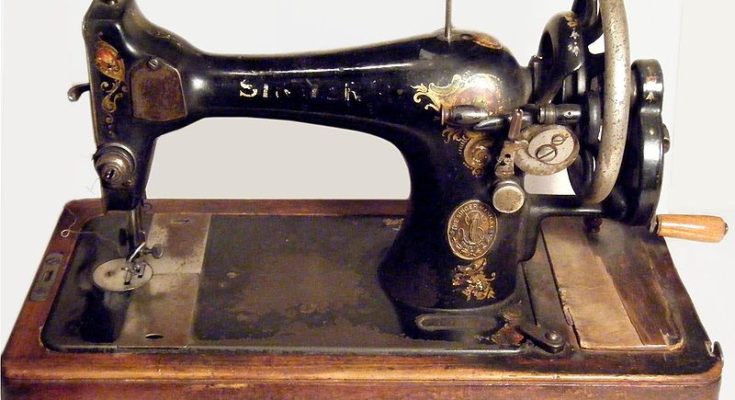Disclosure: This post may contain affiliate links. I earn a small commission when you click a link and make a purchase. Thanks for supporting SewingSociety.com!
I love vintage sewing machines. I think they are beautiful. I’d really love to own an original Singer 66 or 99 model someday.
If you’re lucky enough to get your hands on a vintage sewing machine, I hope you can restore it to its original beauty. That might involve buffing off some rust. This post is all about how to remove rust from your vintage sewing machine without causing further damage.
Disclaimer: Please take safety precautions when using chemicals and tools. SewingSociety.com will not be held liable for any injury to persons or damage to sewing machines. This post is for informational purposes only.
The frame of most vintage sewing machines is made of cast iron, a material that is very susceptible to rust. Vintage sewing machines also tend to have chrome and nickel plating that can rust.
Rust happens when your sewing machine is exposed to moisture and sits for a long time without oil or lubrication…
Removing rust from an antique sewing machine is not easy, but it can be done in most cases. With some work and the right chemicals, you can remove the rust and restore a sewing machine to its original shine.
How to Remove Rust from Faceplates and External Parts
Faceplates with chrome and nickel plating are prone to rust and can tarnish. As the plating wears away, the metal underneath becomes exposed and can start to rust.
To remove rust from faceplates, detach them from your sewing machine. This helps you handle the pieces better and assess the damage. Start by washing the surface with a good degreaser, like Evapo-Rust. Pour some into a container and let your faceplate pieces soak for a few hours. Check back every hour to see if you can rub off the rust. Evapo-Rust is cool because you can reuse it. Once you’re done soaking your pieces, you can simply pour the rust solvent into the can. However, beware that Evapo-Rust can strip the dark finish away from metal, so you should be careful about using it around the black-enamel finish on your sewing machine.
After using a degreaser on your chrome and nickel faceplate pieces, they might look cloudy. You can use a Dremel rotary tool and a buffing wheel to restore the shine. If necessary, you can also use a chrome and metal polish.
Test all chemicals before using them by rubbing a small amount in an inconspicuous place. That way if the chemical does damage, you won’t be able to see it. Be careful around old decals on your old sewing machine if you want them to remain intact.
How to Remove Rust from Internal Parts and Your Frame
If you see rust on the inside of your sewing machine, all hope is not lost. As long as the rust hasn’t gotten to the point where it is pitting the metal and flaking off, you should be able to remove it. There does come a point when you won’t be able to save the machine, but sometimes you can even remove rust that appears to have fused metal pieces together.
To remove rust from internal parts on your vintage sewing machine, begin with a sanding sponge to remove the top layer of rust. Then, you can try removing deeper rust with a Dremel tool and brush wheel attachment.
If the rust is really bad, you’ll need to soak your sewing machine in Evapo-Rust. To do this, remove all the electrical parts and fill a container with rust dissolving solvent. You’ll need a large enough container to fit your sewing machine. Soaking your machine should be a last resort because it will remove black enamel paints and any decorative decals that remained on your vintage sewing machine. When you’re done soaking your sewing machine, use your Dremel tool again to buff away any remaining rust.
I hope you can avoid soaking your sewing machine in Evapo-Rust because it’s practically impossible to repaint your vintage sewing machine like it was before. Although, you could take the opportunity to paint your sewing machine a bright pink or purple. That would be fun!
After removing rust from your vintage sewing machine, always apply oil and lubrication to prevent further rust. If rust is not removed promptly, it can spread to other metal parts on your sewing machine.
Have you ever removed rust from an old, vintage sewing machine? What products did you use successfully? Help others by commenting below.
Share this post on Pinterest!






What buffing brush do you recommend? I have seen some made of cotton, layers of fabric or of wool felt. Some are a flat disc and some a bullet shape.
Hi what year is the vintage singer machine in the picture please as I’ve just been given one the same and would like to know more about it. Rosie
You can find a serial number on the front of your machine. Go to this link and it will help you identify the year and model.
https://ismacs.net/singer_sewing_machine_company/serial-numbers/singer-sewing-machine-serial-number-database.html
I am currently attempting to restore my Grandmother’s old treadle Singer machine. It is 104 years and a Singer No 66. Because it was stored in an old shed there is some water damage to the cabinet and rust everywhere. I am having some success cleaning off the rust but am finding some difficulty with the rust inside. I will take on board your suggestions and see what happens. By the way. The Decals on the Machine were nearly rubbed off by my Grandmother at one time. Do you know where I might be able to get some replacements. The one on there are an Egyptian style with the Lotus flower. Please advise. thank you. Janet.
My email address is all lower case.